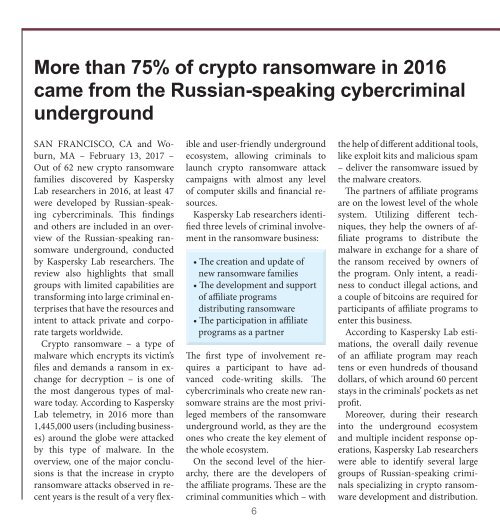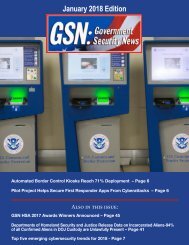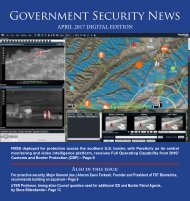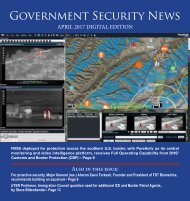Government Security News February 2017 Digital Edition
You also want an ePaper? Increase the reach of your titles
YUMPU automatically turns print PDFs into web optimized ePapers that Google loves.
More than 75% of crypto ransomware in 2016<br />
came from the Russian-speaking cybercriminal<br />
underground<br />
SAN FRANCISCO, CA and Woburn,<br />
MA – <strong>February</strong> 13, <strong>2017</strong> –<br />
Out of 62 new crypto ransomware<br />
families discovered by Kaspersky<br />
Lab researchers in 2016, at least 47<br />
were developed by Russian-speaking<br />
cybercriminals. This findings<br />
and others are included in an overview<br />
of the Russian-speaking ransomware<br />
underground, conducted<br />
by Kaspersky Lab researchers. The<br />
review also highlights that small<br />
groups with limited capabilities are<br />
transforming into large criminal enterprises<br />
that have the resources and<br />
intent to attack private and corporate<br />
targets worldwide.<br />
Crypto ransomware – a type of<br />
malware which encrypts its victim’s<br />
files and demands a ransom in exchange<br />
for decryption – is one of<br />
the most dangerous types of malware<br />
today. According to Kaspersky<br />
Lab telemetry, in 2016 more than<br />
1,445,000 users (including businesses)<br />
around the globe were attacked<br />
by this type of malware. In the<br />
overview, one of the major conclusions<br />
is that the increase in crypto<br />
ransomware attacks observed in recent<br />
years is the result of a very flexible<br />
and user-friendly underground<br />
ecosystem, allowing criminals to<br />
launch crypto ransomware attack<br />
campaigns with almost any level<br />
of computer skills and financial resources.<br />
Kaspersky Lab researchers identified<br />
three levels of criminal involvement<br />
in the ransomware business:<br />
• The creation and update of<br />
new ransomware families<br />
• The development and support<br />
of affiliate programs<br />
distributing ransomware<br />
• The participation in affiliate<br />
programs as a partner<br />
The first type of involvement requires<br />
a participant to have advanced<br />
code-writing skills. The<br />
cybercriminals who create new ransomware<br />
strains are the most privileged<br />
members of the ransomware<br />
underground world, as they are the<br />
ones who create the key element of<br />
the whole ecosystem.<br />
On the second level of the hierarchy,<br />
there are the developers of<br />
the affiliate programs. These are the<br />
criminal communities which – with<br />
6<br />
the help of different additional tools,<br />
like exploit kits and malicious spam<br />
– deliver the ransomware issued by<br />
the malware creators.<br />
The partners of affiliate programs<br />
are on the lowest level of the whole<br />
system. Utilizing different techniques,<br />
they help the owners of affiliate<br />
programs to distribute the<br />
malware in exchange for a share of<br />
the ransom received by owners of<br />
the program. Only intent, a readiness<br />
to conduct illegal actions, and<br />
a couple of bitcoins are required for<br />
participants of affiliate programs to<br />
enter this business.<br />
According to Kaspersky Lab estimations,<br />
the overall daily revenue<br />
of an affiliate program may reach<br />
tens or even hundreds of thousand<br />
dollars, of which around 60 percent<br />
stays in the criminals’ pockets as net<br />
profit.<br />
Moreover, during their research<br />
into the underground ecosystem<br />
and multiple incident response operations,<br />
Kaspersky Lab researchers<br />
were able to identify several large<br />
groups of Russian-speaking criminals<br />
specializing in crypto ransomware<br />
development and distribution.















